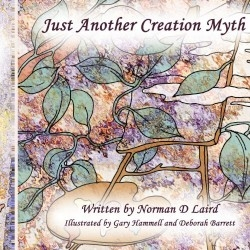
Just Another Creation Myth
The story of creation as told in Genesis is revisited in this tale that pegs itself as a story geared toward those “searching people who are not satisfied with pat religious answers to spiritual questions.” In truth, it is a children’s book with lush illustrations that are the high point of this unenthused tale.
Author Laird closely follows the Genesis story, save for the characters of Adam and Eve who are instead represented by the public at large. In this story God assumes the name of Am Belisha and is so thoroughly overcome by its own creation, that it becomes obsessed with the notion that the creatures must pay homage to it in thankfulness.
As a result, Am Belisha creates a playground for the commoners and claims that they may enjoy every aspect of the area except a structure known as Compassion which is set in the middle of the park. This is obviously a reference to the Apple Tree in the Garden of Eden and just as in that story, the creatures eventually come to play on the structure and enjoy its pleasures. Naturally, Am Belisha is angered and appears before them to condemn their actions. The ending is a surprise as it differs greatly from the original tale.
As vivid as the illustrations that accompany this story are, the language used within is too complicated and vast for children and perhaps even teenagers to comprehend. Take for example this passage: “Am Belisha had an ego. This is not unusual for gods. It is something they have when very young, but they do outgrow their need for it. Apparently at one time we humans needed an appendix but we don’t anymore.”
The preceding passage also raises the matter of incongruity in the crafting of the tale, as the author tends to break in several times and change the rules set forth by himself almost instantaneously. At one point, the author claims that it is a rare experience for a god to enter another’s painting (creation). But Laird quickly changes his position to meet the needs of the story by saying that in fact it happens every time a god creates its first painting.
This story is far too complicated and inordinate for any youth to comprehend. While the illustrations are vivid and dramatic, they fail to breathe life into the story and can even be brought into question as at one point a naked woman is shown dangling from a vine. Sadly, this tale pales in comparison to the original, regardless of its target audience.
Reviewed by
Liam Brennan
Disclosure: This article is not an endorsement, but a review. The publisher of this book provided free copies of the book and paid a small fee to have their book reviewed by a professional reviewer. Foreword Reviews and Clarion Reviews make no guarantee that the publisher will receive a positive review. Foreword Magazine, Inc. is disclosing this in accordance with the Federal Trade Commission’s 16 CFR, Part 255.
